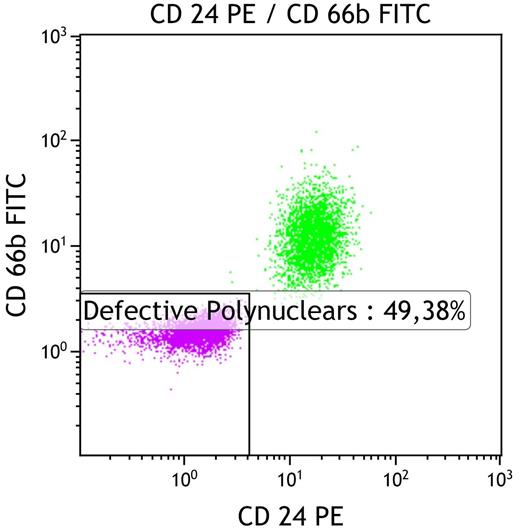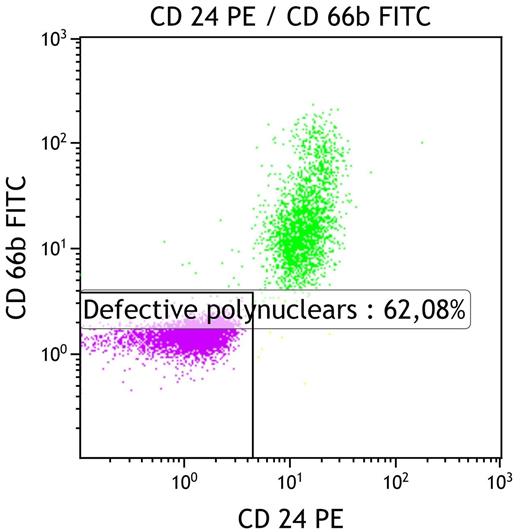Abstract
Paroxysmal nocturnal hemoglobinuria (PNH) is a rare acquired disease, associated with hemolytic anemia and bone marrow failure. The cellular abnormality is a mutation in the phosphatidylinositol glycan class (PIG A) resulting in a deficiency of glycosylphosphadityl-inositol (GPI)-anchored complement regulatory proteins, including CD 55 and CD59, on the surface of blood cells.
Case report
We report the case of a French, 81 year-old-man, who was admitted to our institution with an unusual clinical presentation. He had a rheumatologic monitoring in the context of polyarthritis associated with anemia (98g/L).
No hemolytic events were noticed and there was no notion of either transfusion.
Biological results showed hemolytic regenerative anemia (98g/L) with 136G/L of reticulocytes, neutrophil polynuclears (4.2G/L) without degranulation and nevertheless rare degranulation cells, no blasts, normal level of platelets (258G/l), increase of LDH (Nx3), low haptoglobin (0.07g/L), negative direct Coombs test.
The cytology aspect of medullar cells associated dysgranulopoiesis with degranulation of myeloid lineage and abnormal chromatin condensation, dyserythropoiesis, dysmegacaryopoiesis, in favor of a multilineage dysplasia without blasts. The marrow karyotype was normal.
Due to the morphological results observed on the blood smear and their dissociation with the medullary cytology, flow cytometry (FC500) for GPI‘s expression study was performed.
The used antisera were: CD55, CD59, CD14, CD16, CD24, CD66b, CD157, no FLEAR was tested.
Results
| . | Blood . | Bone marrow . |
|---|---|---|
| Mononuclear cells CD14 FL3 | 78% intermediar cells | 70% negative cells |
| Neutrophil cells CD16 PE | 56% intermediar cells | 56% negative cells |
| Neutrophil cells CD66b FITC | 57% negative cells | 70% negative cells |
| Granular cells CD24 PE | 49% negative cells | 62% negative cells |
| Red cells CD55 FITC | 10% negative cells | 11% negative cells |
| Red cells CD59 FITC | 12% negative cells | 12% negative cells |
| . | Blood . | Bone marrow . |
|---|---|---|
| Mononuclear cells CD14 FL3 | 78% intermediar cells | 70% negative cells |
| Neutrophil cells CD16 PE | 56% intermediar cells | 56% negative cells |
| Neutrophil cells CD66b FITC | 57% negative cells | 70% negative cells |
| Granular cells CD24 PE | 49% negative cells | 62% negative cells |
| Red cells CD55 FITC | 10% negative cells | 11% negative cells |
| Red cells CD59 FITC | 12% negative cells | 12% negative cells |
The confirmation was obtained by using CD157PE antisera on bone marrow with 70% negative mononuclear and granular cells.
The results confirmed the PNH clone’s presence in the blood and also in bone marrow, and the results of flow cytometry could explain the cytological aspect of neutrophil polynuclear cells. It is rare to explore the expression of GPI molecules in bone marrow and there is no publication about the PNH clone whose identification required bone marrow cells for the confirmation of abnormalities in blood. Thus, the apoptosis in the bone marrow of the defective myeloid cells would explain the difference of granularity of polynuclear cells between bone marrow and blood smear.
Conclusion
The significance of this observation is related to the search of a PNH clone when cytological dissociation is observed between the peripheral blood and bone marrow, associated with biological hemolysis arguments (increased LDH and decreased haptoglobin).
It is well known that 6 at 8% of myelodysplasia had PNH clone; the originality of this case report is the initial clinical signs and the laboratory proof of PNH in the blood and the bone marrow.
This observation was submitted at the national reference center of PNH in France (St Louis Hospital - Hematology Department - Professor SOCIE) and the treatment by eculizumab was introduced.
No relevant conflicts of interest to declare.
Author notes
Asterisk with author names denotes non-ASH members.



This feature is available to Subscribers Only
Sign In or Create an Account Close Modal